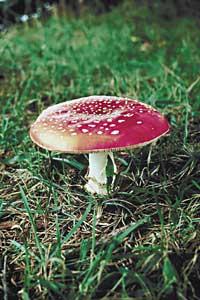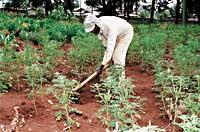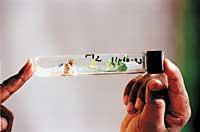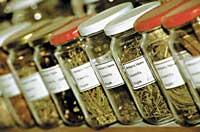Asuncion Azpeitia: "Until 50 years ago, humans have mainly used plants to cure"

Given the unified intention of the European Union to harmonize the regulation on medicines with medicinal plants, we wanted to know what changes would occur with respect to current regulations and laws.
And it is that the countries of the European Union have different customs and laws on medicinal plants, and the countries that have now been incorporated will also have them. Therefore, a great effort must be made to harmonize the rules, but at least it will be clear which medicinal plants can be used, how they should be marketed, with what information, etc. And that will benefit everyone.
Before, there have been changes in Spanish regulations, right?Well, yes. Earlier this year the Ministry of Health and Consumption published the list of medicinal plants to be removed from the market. However, there has been no major change, as the plants listed on this list were already discarded or had very limited use. For example, in the list appears Amanita muscaria, but before I don't think anyone ate in tortilla.
When such lists are published or it is simply prohibited to sell some medicinal herb for its toxicity, some may become frightened and think that medicinal plants are dangerous. And on the one hand they are right, medicinal plants cannot be taken in any way, because they are precisely healing. However, they do not realize that the same thing happens with chemical drugs: they must be taken responsibly and, in addition, periodically some are removed because it produces unexpected effects.
From nature to pharmacy, what path do medicinal plants follow?
Medicinal plants sold in the pharmacy are planted, not wild. The process is controlled from the beginning. First, the characteristics of the soil are taken into account: the soil must be the ideal one for the plant to produce the active component and accumulate in the necessary part. In addition, plant growth is controlled to prevent disease, pollute the environment, etc. Otherwise, this can affect the body of the recipient.
The medicinal plant is then taken to the processing plants. There it is selected: weeds that have been mixed between medicinal plants are eliminated and the necessary part of the medicinal herb is separated. For this, the collection is done at the appropriate time; if necessary, the flower is collected in the flower and if necessary the fruit is left until it is produced.
Then laboratory tests are performed and finally prepared for sale, either whole, crushed or in infusion bags. Also, some medicinal plants are also sold in grageas, so they can be as easy to take as chemical medicines.
They seem to make a path simpler or more straightforward than medicines.Yes, but keep in mind that we have centuries of experience in medicinal plants. Until about 50 years ago, humans have used plants to cure and care. However, we have a brief memory and believe that the drugs we have in the pharmacy have always existed. But in reality it is the opposite: despite having forgotten it, medicinal plants are always.

A few years ago the chemical medicine industry suffered a slowdown that caused the resurrection of the use of medicinal plants. Initially, medicinal plants began to be investigated by the pharmaceutical industries in the search for active components for later synthesis in laboratory. However, they observed that sometimes the isolation of the active components did not affect, so it was better to use the plant.
Consequently, medicinal plants are now in the pharmacy and are also guaranteed by laboratories.
What is the difference between buying medicinal plants in pharmacy or herbalism?The difference is above all in the wisdom of the seller. In the pharmacy career is taught botany, where you learn what are medicinal plants, what active ingredients have, how they are prepared, how to use them... It is true that if you do not put into practice what you learned is forgotten, and that is why now pharmacists are doing recycling courses. We have to update it because plants that were previously not in the market, Asian, American are appearing... Others have reappeared after a long period of marginalization. That is why it is very important to be up to date.
Insufficient with the information provided by medicinal plants in the packaging. The producer may have sold the medicinal plant with full warranty, but the seller should know what it is for and how to use it. In addition, you have to ask some questions, such as whether you are taking other medications, as there may be interactions. It should also ensure the absence of contraindications. And if doctors also knew medicinal plants, better. We would have fewer problems.

It will also explain to the public how medicinal plants often affect. In fact, herbal treatments are usually long and surprise young people who take so long to detect the benefit. Older people, on the other hand, are not surprised because they still remember how medicinal plants are.
So at least some know and use medicinal plants...Yes, yes. In fact, before there was a strong culture of medicinal plants, and the baserritarras knew what medicinal herb to use, for what and how. Today, however, that wisdom is lost and that is why it is important to be in the hands of people who know.
With all this I do not mean that medicinal plants are only sold in pharmacy, but it is a guarantee. In addition, herbalists are only here. In the rest of Europe, 70% of medicinal plants are sold in pharmacies and 30% in large commercial areas. In Spain, however, only 30% is sold in pharmacies. With the new Directive it is intended to control that in shopping centers only sell the most known plants (chamomile, lime...) and everything else in authorized places.
What are the main changes the directive will bring?
From now on, the rules that medicinal plants must meet will be almost as strict as those of medicines. Any medicinal plant, in order to market it, must be registered and present laboratory tests. In addition, the production process will have strict quality controls and will correctly define the information to be placed in the box. Authorizations will be granted by the Ministry of Health and Consumption.
In principle two types of products will be differentiated: “medicines based on medicinal plants” and “traditional medicines based on medicinal plants”. That is, they are only distinguished in a word and will be considered traditional medicinal plants used uninterruptedly for at least 30 years. They will have registration facilities.
At the same time, a commission will be set up, among others, to prepare the monographic sheet of each medicinal plant. There they will discover where the plant grows, what parts are used, for what, how... Everything. Therefore, the current situation will return.
Buletina
Bidali zure helbide elektronikoa eta jaso asteroko buletina zure sarrera-ontzian











